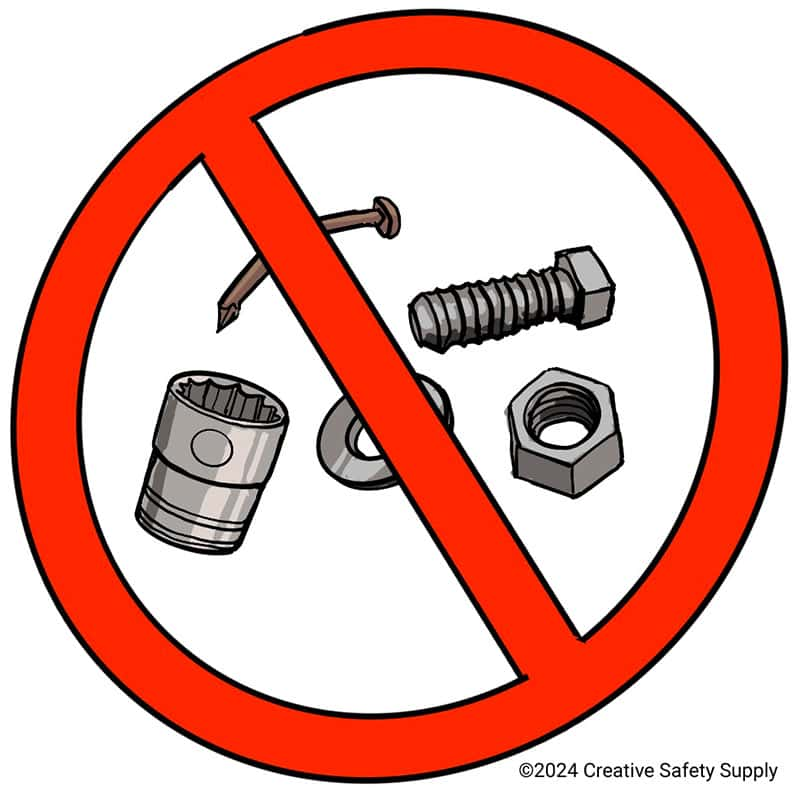
FOD is an acronym that stands for “Foreign Object Debris.” It refers to items or objects in places or situations where they are not supposed to be. Typically, in areas where systems, machinery, or vehicles operate, such as aviation or manufacturing facilities. The placement or presence of these objects can cause damage, malfunctions, or even safety hazards.
Foreign object debris (FOD) can be as simple as a nut or bolt, but can vary from sector to sector.

Aviation
Loose hardware, tools, parts, pavement fragments, trash, wildlife, and even natural debris like rocks or sand are considered foreign object debris. For instance, the crash of Air France Flight 4590 in 2000 was caused by a FOD-induced rupture of the fuel tank after the plane ran over a metal strip on the runway.
FOD related incidents can include:
- Shredded fan blades when sucked into a turbojet
- Blown out tires at high speeds
- Damaged delicate components when trapped inside of an equipment housing
- Frozen control mechanisms when lodged next to levers and handles
- Crashed aircraft due to engine failure or loss of control
Manufacturing/Food Processing
Extra bolts, unsorted tools, metal chips, rags, gloves, hats, where they are not required are considered foreign debris objects in a warehouse/plant.
In the food industry, trash, food wrappers, beverage containers, hair, nails, plastic, rocks, sand, and loose vegetation are common examples of foreign debris objects.
These assorted items can have lasting consequences, such as:
- Reduced safety and reliability of the product or system
- Increased maintenance and repair costs and time
- Decreased productivity and efficiency of the operation or process
- Lowered quality and performance of the product or system
- Increased liability, litigation risks, and costs
- Damaged reputation and customer satisfaction
FOD is a serious concern in specific industries that threaten human well-being and overall livelihood. At Creative Safety Supply, we provide FOD products for a clean and safe working environment. Let us help you create the ideal working environment for you and your employees.
Additional FOD facts:
- According to a study by the National Aerospace FOD Prevention, Inc. (NAFPI), the annual cost of FOD to the global aerospace industry is estimated to be around $4 billion, and the annual cost of FOD to the U.S. Air Force is estimated to be around $100 million. The study also found that FOD incidents have resulted in more than 500 fatalities and more than 1,000 injuries since 1959. Source: https://www.nafpi.com/fod-facts/
- According to a report by the International Air Transport Association (IATA), the average cost of a single FOD incident for a commercial airline is around $313,000, and the average cost of a single FOD incident for a cargo airline is around $619,000. The report also revealed that the most common types of FOD found on runways are metal, rubber, plastic, and organic materials. Source: https://www.iata.org/en/programs/ops-infra/fod/
- According to a survey by the Flight Safety Foundation (FSF), the most effective methods for FOD detection and removal are visual inspections, mechanical sweepers, and FOD detection systems. The survey also identified the main challenges for FOD management as lack of awareness, lack of resources, lack of coordination, and lack of standards. Source: https://flightsafety.org/asw-article/fod-management/
- According to a case study by the NASA Glenn Research Center, the implementation of a FOD prevention program in a jet engine test facility resulted in a significant reduction in FOD incidents, from 18 in 2010 to zero in 2012. The case study also estimated that the FOD prevention program saved the facility around $2.5 million in potential damages and delays. Source: https://ntrs.nasa.gov/api/citations/20140017202/downloads/20140017202.pdf
- According to a research paper by the International Journal of Engineering and Technology (IJET), the application of a FOD risk assessment model in a Malaysian airport showed that the most critical FOD sources were aircraft maintenance, ground handling, and wildlife. The research paper also suggested some mitigation measures, such as improving FOD awareness, enhancing FOD reporting, and implementing FOD detection systems. Source: https://www.sciencepubco.com/index.php/ijet/article/view/11315


